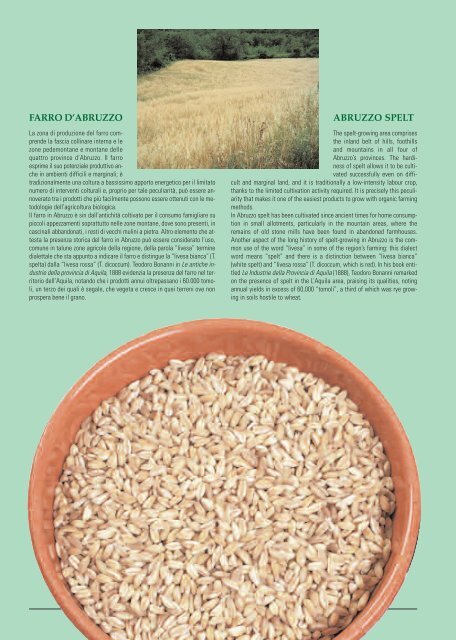9,4 Mb - formato pdf - Enoteca Regionale
9,4 Mb - formato pdf - Enoteca Regionale
9,4 Mb - formato pdf - Enoteca Regionale
You also want an ePaper? Increase the reach of your titles
YUMPU automatically turns print PDFs into web optimized ePapers that Google loves.
FARRO D’ABRUZZO<br />
La zona di produzione del farro comprende<br />
la fascia collinare interna e le<br />
zone pedemontane e montane delle<br />
quattro province d’Abruzzo. II farro<br />
esprime il suo potenziale produttivo anche<br />
in ambienti difficili e marginali; è<br />
tradizionalmente una coltura a bassissimo apporto energetico per il limitato<br />
numero di interventi colturali e, proprio per tale peculiarità, può essere annoverato<br />
tra i prodotti che più facilmente possono essere ottenuti con le metodologie<br />
dell’agricoltura biologica.<br />
Il farro in Abruzzo è sin dall’antichità coltivato per il consumo famigliare su<br />
piccoli appezzamenti soprattutto nelle zone montane, dove sono presenti, in<br />
cascinali abbandonati, i resti di vecchi mulini a pietra. Altro elemento che attesta<br />
la presenza storica del farro in Abruzzo può essere considerato l’uso,<br />
comune in talune zone agricole della regione, della parola “livesa” termine<br />
dialettale che sta appunto a indicare il farro e distingue la “livesa bianca” (T.<br />
spelta) dalla “livesa rossa” (T. dicoccum). Teodoro Bonanni in Le antiche industrie<br />
della provincia di Aquila, 1888 evidenzia la presenza del farro nel territorio<br />
dell’Aquila, notando che i prodotti annui oltrepassano i 60.000 tomoli,<br />
un terzo dei quali è segale, che vegeta e cresce in quei terreni ove non<br />
prospera bene il grano.<br />
ABRUZZO SPELT<br />
The spelt-growing area comprises<br />
the inland belt of hills, foothills<br />
and mountains in all four of<br />
Abruzzo’s provinces. The hardiness<br />
of spelt allows it to be cultivated<br />
successfully even on difficult<br />
and marginal land, and it is traditionally a low-intensity labour crop,<br />
thanks to the limited cultivation activity required. It is precisely this peculiarity<br />
that makes it one of the easiest products to grow with organic farming<br />
methods.<br />
In Abruzzo spelt has been cultivated since ancient times for home consumption<br />
in small allotments, particularly in the mountain areas, where the<br />
remains of old stone mills have been found in abandoned farmhouses.<br />
Another aspect of the long history of spelt-growing in Abruzzo is the common<br />
use of the word “livesa” in some of the region’s farming: this dialect<br />
word means “spelt” and there is a distinction between “livesa bianca”<br />
(white spelt) and “livesa rossa” (T. dicoccum, which is red). In his book entitled<br />
Le Industrie della Provincia di Aquila (1888), Teodoro Bonanni remarked<br />
on the presence of spelt in the L’Aquila area, praising its qualities, noting<br />
annual yields in excess of 60,000 “tomoli”, a third of which was rye growing<br />
in soils hostile to wheat.


